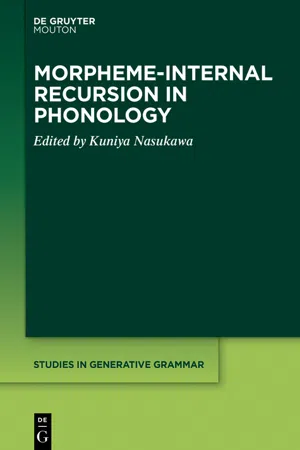
- 424 pages
- English
- ePUB (mobile friendly)
- Available on iOS & Android
Morpheme-internal Recursion in Phonology
About this book
Generative phonology aims to formalise two distinct aspects of phonological processes: the functional and the representational. Since functions operate on representations, it is clear that the functional aspect is influenced by the form of representations, i.e. different types of representation require different types of rules, principles or constraints. This volume examines the representational issue in phonology and considers what kind of representation is most appropriate for recent models of generative phonology. In particular, it provides the first platform for debate on the place of morpheme-internal structure and on the formal status of phonology in the language faculty, and attempts to identify phonological recursive structure as a means of capturing frequently observed processes.
Frequently asked questions
- Essential is ideal for learners and professionals who enjoy exploring a wide range of subjects. Access the Essential Library with 800,000+ trusted titles and best-sellers across business, personal growth, and the humanities. Includes unlimited reading time and Standard Read Aloud voice.
- Complete: Perfect for advanced learners and researchers needing full, unrestricted access. Unlock 1.4M+ books across hundreds of subjects, including academic and specialized titles. The Complete Plan also includes advanced features like Premium Read Aloud and Research Assistant.
Please note we cannot support devices running on iOS 13 and Android 7 or earlier. Learn more about using the app.
Information
Obstruent liquid clusters: Locality, projections and percolation
1 Introduction
2 Unexpected properties of OL clusters
2.1 Mono or bipositionality

Table of contents
- Title Page
- Copyright
- Contents
- Introduction
- Recursion in melodic-prosodic structure
- A theory of the theory of vowels
- On some deep structural analogies between syntax and phonology
- Decomposition and recursive structure: Glide formation and vowel lowering in East Asian languages
- Multi-layered recursive representations for depressors
- Embedding of the same type in phonology
- Velar softening without precedence relations
- Recursion and GP 2.0
- Head, dependent, or both: Dependency relations in vowels
- Defining recursive entities in phonology: The Onset Prominence framework
- Obstruent liquid clusters: Locality, projections and percolation
- Recursive strong assignment from phonology to syntax
- Language Index
- Subject Index